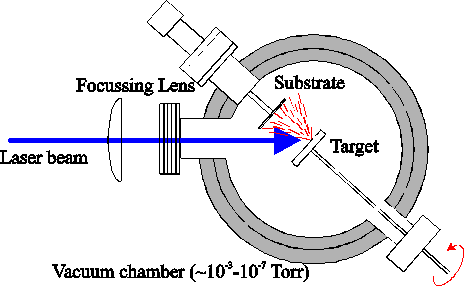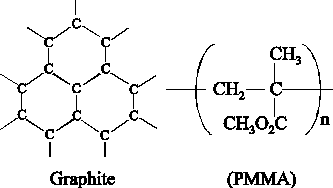
Pulsed UV Laser Ablation of Carbon Containing Targets

Introduction
Pulsed Laser Deposition (PLD) has now been proved as a versatile and reliable technique for the deposition of a wide variety of materials and compounds ranging from high-temperature superconductors, ferroelectrics, metals, polymers, ceramics through to diamond-like-carbon thin films. The experimental set-up and procedure is relatively simple (see below) compared to the extreme complexity of the ablation process itself, since this involves laser-solid interaction at the target, plasma formation and directional transport of material to the substrate on which deposition takes place.

The PLD process has numerous parameters and are chosen so to be optimum for the specific application, for example: wavelength, target material, fluence (Energy/unit area), vacuum conditions, presence/pressure of a ambient gas be it inert or reactive, angle of incident of laser beam relative to target surface and substrate temperature.
Here at Bristol the main thrust of ablation work is involved in the production of thin films of diamond-like carbon (DLC). The title DLC covers a wide range of materials often produced from very different deposition techniques, producing materials that possess an extremely wide range of physical properties due to varying amounts of hydrogen and sp2/sp3 bonded carbon . The detailed composition and properties of such films depends sensitively on the exact parameters employed during their preparation.
Ablation of graphite under vacuum leads to the condensation of high energy carbon atoms, ions and clusters onto the substrate. The high energy of the incident particles provides the driving force to convert from sp2(graphite) to sp3(diamond) bonded carbon. These films are extremely smooth (on the nm scale), hydrogen free and are termed amorphous carbon (a-C), whilst still being under the heading of DLC. Such films with high sp3:sp2 ratios are often referred to as tetrahedral amorphous carbon (ta-C).
PLD from graphite in the presence of hydrogen gas offers one route for the deposition of hydrogenated amorphous carbon films (a-C:H). Ablation of polymeric targets such as polycarbonate or poly(methyl methacrylate) under vacuum or in the presence of hydrogen provides another. a-C:H films offer similar properties to a-C films whilst allowing the variation of optical band gap simply by varying the hydrogen content within the films.
These films display many of the same attractive physical properties as polycrystalline diamond, whist deposition is possible at room temperature. This is the key advantage over other techniques such as CVD which require the substrate to be maintained at elevated temperatures (~1000 K). This allows deposition onto temperature sensitive substrates such as glass and plastics. Since this material is a mixture of sp2 and sp3 bonded carbon it is highly defective which leads to it possessing a low electron affinity and excellent electron emission characteristics. This has caused great interest for potential use as a cold cathode emission devices (flat panel displays). The low temperature deposition makes this technology compatible with delicate microelectronic circuitry and silica glass substrates. Deposition using a mask allows patterned a-C and a-C:H films to be produced, which is one of the prerequisites to using them in field emission devices.
Little is known about the formation, propagation and chemical composition of laser plasmas and majority of the work undertaken in the last two years has been concentrated on trying to understand the processes involved in the transport of material from the target to the substrate and how these affect film characteristics.
 The majority of work done to date has involved the ablation of both poly(methyl methacrylate) (PMMA) and ultra pure graphite using the ArF excimer wavelength of 193 nm. This has been both in vacuo and in low background pressures of gas (Ar, He, and H2). The expanding ablation plume has been investigated extensively via optical emission spectroscopy, this has been in the form of spatially resolved wavelength dispersed emission spectra or by species selective time gated CCD imaging.
The majority of work done to date has involved the ablation of both poly(methyl methacrylate) (PMMA) and ultra pure graphite using the ArF excimer wavelength of 193 nm. This has been both in vacuo and in low background pressures of gas (Ar, He, and H2). The expanding ablation plume has been investigated extensively via optical emission spectroscopy, this has been in the form of spatially resolved wavelength dispersed emission spectra or by species selective time gated CCD imaging.
Other diagnostic techniques used on the expanding plume have been Quadrupole Mass Spectroscopy (QMS), and ion probe measurements. The as deposited films have been studied using Scanning Electron Microscopy (SEM), Fourier Transform Infra-Red Spectroscopy (FTIR), Microcombustion Analysis (MCA), Field Emission (FE) and Laser Raman Spectroscopy (LRS).
Index of experimental set-ups.
Back to :-
![]() Bristol University Chemistry Home Page.
Bristol University Chemistry Home Page.